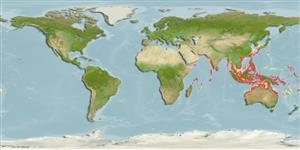Common names from other countries
Environment: milieu / climate zone / depth range / distribution range
Écologie
; profondeur 0 - 40 m (Ref. 349). Tropical
Distribution
Pays | Zones FAO | Écosystèmes | Occurrences | Introductions
Indo-West Pacific: from Madagascar and the Persian Gulf, to eastern Melanesia; north to Japan and south to Queensland and New Caledonia.
Length at first maturity / Taille / Poids / Âge
Maturity: Lm ? range ? - ? cm Max length : 4.5 cm SHL mâle / non sexé; (Ref. 349); common length : 3.0 cm SHL mâle / non sexé; (Ref. 349)
Used as food and for its shell (Ref. 349). From shallow subtidal levels. Members of the family Naticidae are sand or mud-dwelling, ploughing through the substrate with their expanded foot. They are active predators, preying mainly on burrowing bivalves or gastropods (Ref. 349).
Life cycle and mating behavior
Maturité | Reproduction | Frai | Œufs | Fécondité | Larves
Members of the order Neotaenioglossa are mostly gonochoric and broadcast spawners. Life cycle: Embryos develop into planktonic trocophore larvae and later into juvenile veligers before becoming fully grown adults.
Poutiers, J.M. 1998. (Ref. 349)
Statut dans la liste rouge de l'IUCN (Ref. 130435)
statut CITES (Ref. 108899)
Not Evaluated
Not Evaluated
Menace pour l'homme
Harmless
Utilisations par l'homme
| FishSource |
Outils
Plus d'informations
Taille/ÂgeCroissanceLongueur-poidsLongueur-longueurMorphologieLarvesAbondance
Sources Internet
Estimates based on models
Preferred temperature
(Ref.
115969): 24.6 - 29.1, mean 28.2 (based on 1044 cells).
Vulnérabilité
Low vulnerability (10 of 100).
Catégorie de prix
Unknown.
